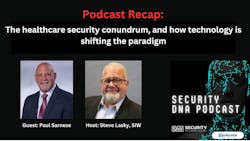Podcast Recap: The healthcare security conundrum, and how technology is shifting the paradigm
When imagining dangerous workplaces, hospitals and doctor's offices are unlikely to score high ranks on a layman's list. However, those employed in the field are all too familiar with its perils. Healthcare is one of the riskiest sectors in the United States, and an unstable post-COVID-19 political climate promises a difficult future for its professionals if efforts aren't made to ensure their safety.
In this episode of SecurityDNA, join SecurityInfoWatch Editorial Director Steve Lasky and Paul Sarnese, the Owner and Founder of Secured & Prepared Consulting, for a riveting discussion about the underlying causes of workplace violence, the spotlight COVID-19 shone on the risks shouldered by healthcare professionals, and Sarnese’s experiences managing the safety, security, communications, supplies and care of over 11,000 Afghan refugees following the U.S. withdrawal from Afghanistan.
Sarnese: “In the middle of COVID, we were considered ‘healthcare heroes,’ but those ‘healthcare heroes’ were still getting assaulted.”
Paul Sarnese is a renowned expert in healthcare safety, security, and emergency management, lending weight to his insights on workplace violence mitigation. His 35 years of work experience in the field are colored by his experiences as AVP of Safety, Security and Emergency Management at Virtua Health, Corporate Director of Safety, Security and Emergency Management at Liberty Health, and more.
Leveraging these 35 years of experience to design quality, resilience and safety programs for healthcare facilities, Sarnese leads Secured & Prepared Consulting on a mission to safeguard healthcare organizations by providing robust solutions and a wealth of industry expertise.
Find this month’s episode of SecurityDNA here.
WHAT YOU WILL LEARN
- What the indicators of simmering workplace violence are,
- Why communication with facility staff is important to maximizing security gains,
- Where the clinical component comes in when identifying high-risk patients,
- How Sarnese’s work with special needs patients set industry standards for vaccination,
- And how the security and safety business often extends beyond the hospital doors.

